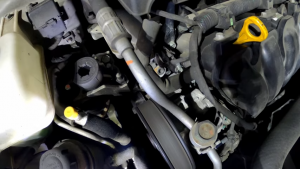How To Stop Belt From Squeaking
In the stillness of the morning, as the world awakens to the gentle touch of the sun, a symphony of engines stirs to life. Yet, amid this automotive overture, there emerges an unsettling sound that has puzzled drivers for generations – the haunting squeak of a cold start. As you turn the key or press the ignition button, the engine’s initial purr is accompanied by a dissonant squeal, leaving you to wonder, “What does this mean? Is it the timing belt that needs changing, or could there be another culprit behind this mysterious morning melody?”

In the world of automobiles, there exists an elusive and irritating phenomenon that has haunted drivers for generations. A sound so piercing and relentless that it can transform a serene drive into a cacophony of annoyance – the dreaded belt squeak. Whether you’re cruising down a scenic highway or navigating the busy city streets, this high-pitched screech seems to emerge from the depths of the engine, leaving drivers puzzled and passersby cringing.
So, fasten your seat belts, dear readers, as we embark on this riveting journey through the mysterious realm of belt squeaks.
What is a Car Belt?
A car belt, also known as a drive belt or serpentine belt, is a crucial component of the engine’s accessory drive system. It is typically a rubber-based belt with grooves on one side, designed to transfer power from the engine’s crankshaft to various accessories and components. These accessories may include the alternator, air conditioning compressor, power steering pump, water pump, and more, depending on the vehicle’s make and model.
The serpentine belt is called so because of its serpentine or snake-like path as it winds around the various pulleys connected to the accessories. As the engine runs, the belt rotates these pulleys, driving the accessories and ensuring they function properly.
Lifetime of a Car Belt
The lifespan of a serpentine belts, designed to endure longer than their predecessors, can vary depending on factors such as the quality of the belt, driving conditions, and maintenance practices. In general, modern serpentine belts are designed to last longer than older V-belts. They typically have a lifespan of around 60,000 to 100,000 miles (approximately 96,500 to 160,000 kilometers) or 5 to 7 years, but this can vary. Some higher-quality belts may last longer, while others might wear out sooner, especially if subjected to harsh conditions. When the time comes for a replacement, the cost typically amounts to a couple hundred dollars, factoring in both parts and labor. Rest assured, a timely adjustment or change will restore the harmony to your engine’s symphony, allowing you to enjoy many more smooth morning starts on your automotive journey.
Signs of Belt Wear and Replacement
As the belt ages and undergoes stress, it may show signs of wear, such as cracks, fraying edges, or glazing on its surface. Squealing or chirping noises during cold starts or when operating accessories can also indicate a worn-out belt. Additionally, if you notice a loss of power steering, a dead battery, or an overheating engine, the serpentine belt might be the culprit.
It is essential to inspect the belt regularly and replace it promptly if any signs of wear or damage are detected. Regular maintenance and replacing the belt before it fails can help prevent unexpected breakdowns and potential damage to other engine components.
It’s important to consult your vehicle’s manual for specific recommendations regarding the replacement interval and maintenance of the serpentine belt. Additionally, a qualified mechanic can provide guidance and ensure the proper installation of a new belt, ensuring your vehicle’s smooth and efficient operation.
Identifying the Reasons for Squeaky Belts
To silence the relentless screech, we must first understand the origins of this irksome noise. Unraveling the mysteries of the squeaky belt requires us to navigate through the web of potential culprits, with each thread leading to a unique cause.
Belt Tension
One of the primary factors behind a squeaky belt lies in its tension. Like a symphony conductor seeking perfect harmony, the tension in the belt must be precisely calibrated to orchestrate flawless performance. Too loose, and the belt slips, causing a discordant screech as it struggles to maintain a grip on the pulleys. Conversely, excessive tension can lead to undue stress on the belt, shortening its lifespan and generating unwarranted noise.
Worn or Damaged Belt
As the miles add up and the engine roars through the passages of time, the belt undergoes a gradual metamorphosis. Wear and tear become inevitable companions on this automotive journey, with the belt’s once smooth surface giving way to abrasions and imperfections. A belt nearing the end of its life is prone to squeaking as it grapples with the inevitable frictions and slips that accompany its weariness.
Pulley Misalignment
The automotive pulley system functions like a finely-tuned ballet, each pulley playing its role in perfect synchrony. However, in the delicate choreography of the engine’s mechanics, misalignment can sneak in like a mischievous dancer, disrupting the harmony. When pulleys fall out of step, they force the belt to waltz along an irregular path, causing it to rub against the edges and creating an unsettling symphony of squeaks.
Contaminants
Amidst the pristine confines of the engine bay, the belt faces a relentless barrage of external elements eager to join the vehicular performance. Dirt, debris, and even the occasional oil or coolant spill find their way onto the belt’s surface, infiltrating the once smooth texture. As the belt spins, these contaminants act as unseen conductors, orchestrating an impromptu chorus of squeaks and squeals.
As we venture deeper into this investigative journey, armed with the knowledge of the common causes, we can begin our quest to quell the discordant serenade of the squeaky belt. From precision belt tensioning to identifying the faintest pulley misalignments, and even the cleansing rituals that rid the belt of unwelcome contaminants – our mission will be to restore the symphonic serenity to the engine bay.
Step-by-Step Guide to Fix Car Belt Noise
- Inspect the Belt: As you embark on your quest to silence the enigmatic belt squeak, begin with a thorough visual inspection. Pop open the hood and carefully examine the belt’s surface for any telltale signs of wear, damage, or contaminants. Look out for cracks, fraying edges, or a shiny glaze that may indicate excessive wear.
- Check Belt Tension: To achieve perfect harmony within the belt system, you must assess its tension with precision. Utilize an appropriate tension gauge to measure the belt’s tightness. If the tension falls outside the manufacturer’s recommended specifications, it’s time to bring it back into harmony. For belts with adjustable tension, follow the vehicle’s manual to make the necessary adjustments.
- Tighten or Replace Belt: A loose or damaged belt is a surefire culprit behind the dissonant symphony. If your inspection reveals that the belt is not taut or exhibits signs of deterioration, it’s time to take action. Use the appropriate tools to tighten the belt to the correct tension, making sure it’s not overly taut. Alternatively, if the belt shows significant wear or damage, it’s best to replace it with a fresh one that can once again serenade the engine with harmony.
- Lubricate Pulleys: Just as a skilled conductor keeps the musicians in harmony, applying a suitable lubricant to the pulleys can significantly reduce friction and prevent squeaking. Be sure to use a lubricant recommended for automotive use and apply it generously to the pulley surfaces. This small act of maintenance will help the belt glide effortlessly across the pulleys, contributing to a melodious engine performance.
- Check Pulley Alignment: A harmonious belt system relies on well-aligned pulleys, dancing together in perfect synchronization. Carefully inspect each pulley’s position to ensure they are all aligned correctly. If any pulleys appear out of step, take the time to realign them, ensuring they create a smooth path for the belt to glide upon.
- Clean the Belt: In the face of external contaminants seeking to join the automotive performance, it’s essential to cleanse the belt’s surface thoroughly. Use a specialized belt cleaner or a mild soap and water solution to wash away any dirt, debris, or fluids that have taken residence on the belt. This cleansing ritual will restore the belt’s smooth texture, eliminating any potential squeak instigators.
- Perform a Test Run: With all fixes completed, it’s time to put the performance to the test. Start the engine and listen keenly for any remaining belt noise. A successful repair mission will be evident if the belt operates quietly and glides smoothly across the pulleys, producing a serene and harmonious engine hum.
Regular Maintenance: To prevent the reappearance of the dreaded belt squeak, remember the importance of regular maintenance. Follow the manufacturer’s recommendations for scheduled inspections and replacements, nurturing the engine’s performance with care and attention. A well-maintained belt system will reward you with a serene driving experience, free from the cacophony of squeaky belts
Video: How to Fix a Squeaky Belt (figure out where the squeak is coming from)
Conclusion
We hope our guide on fixing car belt noise provides valuable tips and step-by-step instructions help you for addressing this common issue. By following these guidelines, car owners can eliminate squeaky belts and enjoy a quieter and smoother driving experience.



